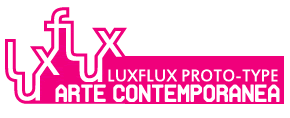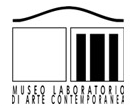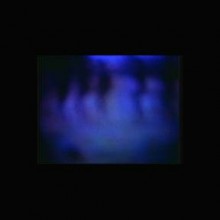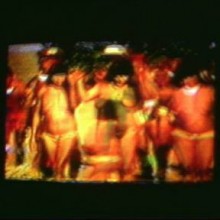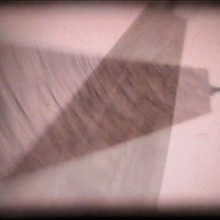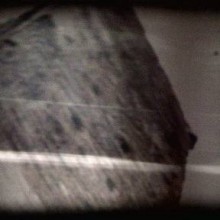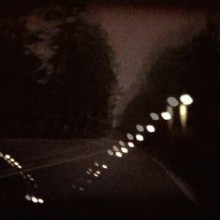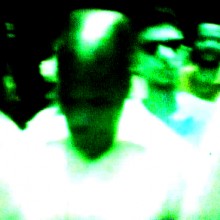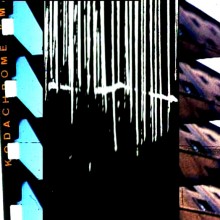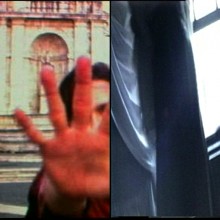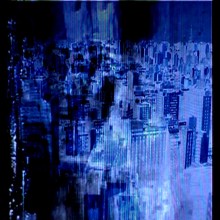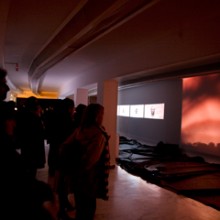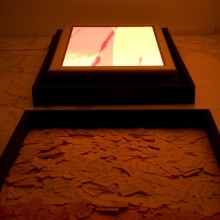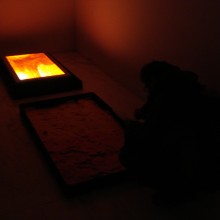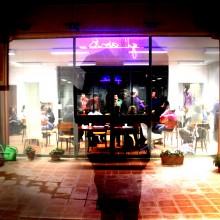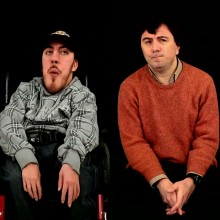Foodnotes
(1) César Meneghetti,_ this_ placement, Rome, 2011 with comments by Antonio Arevalo, Cristina Cannelli, Mike Watson, Simonetta Lux, Francesca Gallo, Bruno of Marino, Elisa Byington, Lucrezia Cippitelli, Solange Farkas, Elisabetta Pandimiglio.
(2) Simonetta Lux, Arte ipercontemporanea. a certo loro sguardo…Ulteriori protocolli dell’arte contemporanea, Rome, 2006, p. 217.
(3) Interview by Giorgia Calò Montage, in Simonetta Lux, op. cit., p. 224
(4) Cfr. Simonetta Lux, op. cit, p. 219
(5) In SLAZAK, Con l’arte. Da disabile a persona (With art. From being disabled to being a person), Rome, Gangemi, 2007, on page 335 there is a chapter on the laws in favour of school integration, with non-separate teaching (contrary to provisions existing in other European countries). By Simonetta Lux, Antonella Antezza, Cristina Cannelli, Alessandro Zuccari.
(6) SLAZAK, Con l’arte. Da disabile a persona, op. cit. , a cura of Simonetta Lux, Antonella Antezza, Cristina Cannelli, Alessandro Zuccari.
(7) César Meneghetti, www.ioeunaltro.org
Bibliography
Simonetta Lux, in ”luxflux proto-type arte contemporanea”, n. 43, 2011, in “Speciali”. Ipercontemporanea I: Apertura del soggetto,
Theodor Wiesegrund Adorno, Philosophie der neuen Musik (Tübingen 1949; Torino 1960). http://www.culturalstudies.it/dizionario/lemmi/teoria_critica_b.html). Come uscire dalla negazione di quella ragione stessa da cui muovono tuttavia le istanze emancipatrici della società, dalla messa in discussione del “pensiero, nel cui meccanismo coattivo la natura si riflette e si perpetua, e riflette, proprio in virtù della sua coerenza irresistibile, anche se stesso, come natura immemore di sé, come meccanismo coattivo”? (Adorno-Horkheimer, Dialettica dell’Illuminismo,1947).
Jean-François Lyotard, La Condition postmoderne: Rapport sur le savoir (1979); Les Immateriaux (1985, Centre Georges Pompidou).
Fredric Jameson, Postmodernism, or, The Cultural Logic of Late Capitalism (inizialmente sulla New Left Review nel 1984), traduzione italiana Il postmodernismo ovvero La logica culturale del tardo capitalismo (Garzanti 1989).
Zygmunt Bauman, Modernity and The Holocaust, Ithaca, N.Y., Cornell University Press 1989; Le sfide dell’etica, 1993.
Gilles Lipovetsky, Le crépuscule du devoir (Gallimard, 1992; Il buio del postmoderno, 2011).
Maurizio Ferraris, La fidanzata automatica (Bompiani, 2007).
Slavoj Žižek, Vivere alla fine dei tempi, 2011, Milano, Ponte alle Grazie (I° ed 2010, Verso ed.)
Simonetta Lux, Arte ipercontemporanea. Un certo loro sguardo… Ulteriori protocolli dell’arte contemporanea, Roma, 2006.
César Meneghetti, Montage 4 (1, 2,, 3, 4, 8, 9, 10, 11),Caput Mundi, 1999
César Meneghetti, Montage 2, Quelli di sotto,1999-2000
Cesar Meneghetti, K_lab_interacting on the realiyt interface, videocabina n. 2, still da video, 2008, Museo Laboratorio di Arte Contemporanea, Sapienza di Roma (see: www.luxflux.net, Museo Laboratorio di Arte Contemporanea- Archivio mostre-2008)
È nel soggetto e nel contesto che ho definito ipercontemporaneo che finalmente l’atto del ricordare e l’atto testimoniale sfuggono al chiuso carattere metaforico dell’opera o della creazione artistica, aprendo l’opera e la creazione dell’arte all’altro attraverso un processo che non si chiude nell’oggetto realizzato ma che si proietta con azione trasformatrice psicologica e culturale negli altri soggetti e ambienti della recezione, con azione di inclusione e partecipazione in un feedback che potremmo quasi dire infinito di azione trasformatrice.
Tale soggetto artista imputa in prima istanza a se stesso, autobiograficamente, le ragioni e il fatto della scelta (dei modi, mezzi, tecniche, procedure e delle tematizzazioni), con ciò rispondendo a quanto Adorno aveva prefigurato come modo di uscire dall’impasse culturale determinata dal non avere noi più potere sulla realtà e sulle strutture di dominio che ci sovrastano: possiamo lavorare solo su noi stessi, egli affermava, considerando ciò il primo punto cardinale della sua pedagogia della resistenza.
In secondo luogo ; di fronte al pessimismo dei filosofi della Scuola di Francoforte verso la razionalità occidentale, l’artista ha allargato alla realtà e ad altri soggetti ed ad altre forme di razionalità e di pensiero la continuità dello svolgersi e dell’operare dell’opera stessa, presumendone l’inclusione fin dall’istituzione dell’opera. Dalla più ampia realtà, come anche dal riconoscimento di quella più reietta e del contesto culturale più trash, sanno che provengono comunque le forze emancipatrici della società.
Quando ho parlato di arte ipercontemporanea e di un certo loro sguardo non mi sono riferita a quell’”oggetto che crede di essere un soggetto”, l’opera d’arte (Maurizio Ferraris, La fidanzata automatica) ma mi sono spostata dall’oggetto al soggetto, mi sono riferita piuttosto a quel soggetto, uomo/donna/artista, che nel mondo globalizzato della fase postmoderna del capitalismo (la III fase, secondo Jameson in Postmodernismo ovvero La logica culturale del tardo capitalismo, 1984/1992) iscrive la propria visione critica su tale mondo, compie un atto etico, nella propria opera: lo fa attraverso un mode d’emploi peculiare di tutti i mezzi possibili di espressione (resi disponibili proprio dalla deregulation di ogni paradigma dell’arte esplosa in ciò che chiamiamo con Lyotard condizione postmoderna): da quelli codificati nelle epoche precedenti, a quelli nuovi da sempre estranei ai paradigmi moderni dell’arte. E lo fa soprattutto misurandosi con situazioni estreme ed opposte (creare ponti tra nazioni e culture lontane; cavalcare normalità/anormalità; intrecciare alto e basso, strati linguistici conformi e strati non conformi), includendo nell’opera e nel processo creativo dell’opera quelle persone della cui condizione l’artista si fa carico di interesse in una condivisione di responsabilità e di eventuale gioia critica della vita e della realtà.
Lo statuto o condizione di tale soggetto e uomo/donna/artista ipercontemporaneo, è statuto di alterità o estraneità al mondo: ma l’artista è, secondo i punti di vista, condannato a (Boris Groys), operare con la e sulla materia di quel mondo oppure responsabile nella scelta di farlo: così César Meneghetti.
Oltre il carattere metaforico dell’opera d’arte e oltre la funzione simbolica del linguaggio artistico (che permangono), oggi l’arte ha esteso ( continua ad estendere) la sua azione fino ad attuare un processo trasformativo vero e proprio nella cultura e nella realtà contemporanea, mutandone a fondo sia gli automatismi pregiudiziali culturali sia la condizione emotiva/affettiva dei soggetti coinvolti dall’artista e dell’artista stesso.
Con l’esperienza di César Meneghetti e la realizzazione delle diverse tappe del work in progress I/O_IO E’ UN ALTRO .JE EST UN AUTRE il paradigma dell’arte come azione trasformatrice del reale si mostra possibile e non solo utopistico, non solo antagonistico, non solo auspicabile.
Nel momento in cui riconosciamo questo paradigma dell’arte, resta da accettare lo statuto dell’arte e dell’azione artistica che così si configura. Resta cioè da accettare il fatto che non tutto è nell’opera realizzata, ma occorre vedere oltre la materialità ed i media della sua apparizione , entrare nel fluido di quei processi interrelati e scambiati che inclusi,o condivisi o intrecciati (backstage e poststage) .
L’azione trasformativa dell’arte è dunque azione nel contesto di una più larga azione critica e emancipatrice che riconosciamo a soggetti diversi del mondo: azione tuttavia peculiare nell’arte, per il carattere immaginifico, sorprendente (e non fatuamente bizzarro) , per il carattere quindi visionario attivo del linguaggio che l’artista mette in campo.
CÉSAR MENEGHETTI’S DOUBLE EMPHASIS ART/REALITY
The double emphasis art/reality specific to César Meneghetti’s work can/must be described also through other opposites: identity /nomadism, crystallization / flow, otherness/prejudice, remembrance/oblivion, normality/diversity, boundary/cross-boundary. Because it is precisely there, along these borders, that Meneghetti’s works and his art are fulfilled.
It is no coincidence that the split-screen that, amongst the countless linguistic techniques he so knowledgeably uses, might have constituted until now a creation trope in the framework of the double emphasis centered along the border between things and conditions, has been discarded in his most recent innovative work, as if the boundary separating conditions and cultural contradictions had been disregarded. Is that the case?
Before this current work, I/O IO È UN ALTRO, the crystallization of a lengthy and challenging project/ process taken through verifications, César Meneghetti had given the dignity of language to splinters, traces, fragments, narrations, sudden parallelisms between distant and opposing worlds: Italy/Brazil, Europe/America, Africa and European science. And using all the devices now available to art – photography, editing, installation, sculpture, film directing and/or screen writing –, he established an antithesis in distance, bringing to light specific issues, making them universal and narrating them, intercepting them thanks to the nomadic or migrant condition he shares with the artists and men of this globalized world. Among his movies, I’m referring, to Landless/Sem Terra (12’30’, 2001) made with Elisabetta Pandimiglio or the abstract Montages that he has been making since 2000 or, closer to us, K_lab – interacting on the reality interface (2009-2011). Landless/Sem Terra narrates the fictitious / realistic tale of the life of a man who never speaks marked by an exceptional event: his birth in the middle of the sea. Born on a ship crowded with migrants who believed they were going to make their fortune in “Merica”, with its vast arable land, this man finds himself growing up in Brazil where the ruling rural aristocracy had replaced slave manpower with more affordable European wage earners. The scandal of the film is at its start, when the man stops speaking, a man doomed from the first day of his life to seek his land without ever finding it. The inexplicability of his inner flare and the narrative through other voices, the voices of the women who loved him in two different corners of the world, the filming method used in a mode of composition that goes against classical movie-making (it lacks continuity in the story and the script) create expectancy and suspense. This work, that is open from the narrative standpoint, and this cinematographic object with no strict planning – its plot taken from a real event from days long past – provides a window on living conditions in Brazil and conditions shared by many in the world today. In K_lab – interacting on the reality interface, the identification and disjunction of two worlds, that on the surface are communicating but in fact are rigidly locked up inside their own borders, is once again unclear: the successful and productive world of Western science, the world of Africa, Niger, suddenly abandoned to a regression in development and the march of desertification. Meneghetti is called to describe the relationship between these two worlds, on the basis of the extended scientific documentation of the success achieved by the Italian governmental project to block desertification by planting 25 million trees and by building complex irrigation systems through techniques both culturally and effectively created by the local population. The artist’s work does not present any documents, large files or statistics relating to the success achieved by scientists and then discontinued by politicians. With his trans-genre capacity and transmediality, Meneghetti has organized his work in an indivisible semantic unity: it achieves complex artistic unity expressed through different parts that are they themselves distinct works: the projections, sculptures, audio/video installations, video-booths, constituting them. Video-booths have been invented by Meneghetti and involved an original procedure: the protagonists, in this case Nigeriens, are called to speak to us about their ideas of God, Love, life, the future and money, returning to us and universalizing life and the views of that distant place that science had helped and politics abandoned(1). Both the works and the Montages involve building upon himself, i.e. upon his own personal history as an artist film-maker, the editing guided by editing itself (the abstract composition of his own movie fragments), a construction guided by his political and cultural subconscious. The prevailing element that has emerged is his technical mastery in giving some of his montages titles like jump, fade in, sequence shot: it is quite obvious that César Meneghetti is molded by what he does, learning from his own works. As he himself has written “after all technique, Montage, only provides a cue to talk about something else, to investigate language and diversity in the cultures and worlds I myself have experienced in South America, Great Britain and Italy, in search of a personal, trans-national, horizontal identity” (2). A critical relationship with techniques is evident in this artist ever since his student days. Subconsciously but perceptively, César Meneghetti has, for example, used (in Montage 6 and in Montage 7) a split-screen, with the aim of establishing contemporaneity in time and place, the notion of a merging of the streets of two cities as different as Sao Paolo in Brazil and Rome or Rome and London. As he himself has pointed out in the interview of 2006 (3), a hyper-non-place, a reality conjured by a specific use of techniques and images are used. The different ways in which media can be used by contemporary artists and formal excellence brought to the limits of abstract art do not disregard the subject, on the contrary, we witness a rediscovery of the centre, a constantly moving centre, a nomadic centre, in an interminable interweaving of individuals, places or environments and so the critical and ethical component becomes a new protocol for art. A new subjectivity lacking expression but having wisdom (4).
When I asked César Meneghetti to work on and with disabled people, the artist knew he was being called to a new representation of the truth through art; what he did not know was that he would break through the indefinite boundary between reality and representation, leading to a real upheaval in the reality of that condition and in his own reality through a shared creative process. Thanks to the relations set in motion by Meneghetti through a process shared with the disabled participants – and the use of media in educating to freedom, thus to the current concept of art – he brought about this upheaval at the peak of a process of revelation and liberation from a condition of reclusion and discrimination initiated years ago through practical institutional initiatives by the Community of Sant’Egidio, with Acts on the creation of non-differential curricula in schools (Act n.517 of 1977 and Act 270 of 1982) (5), through the creation of businesses and jobs and through the creation of the Art Ateliers: we described these activities in the book written jointly by several authors Con l’arte. Da disabile a persona (6) (With art. From being disabled to being a person). If the intelligence and ability to communicate of people with different physical and neurological disabilities has already been proven, thanks also to the tools of augmentative communication (W.O.C.E. Written Output Communication Enhancement), what more can art and artists do, and how? It wouldn’t be fair to say that César Meneghetti wasn’t a suitable artist.
In I/O_IO È a ALTRO, the central theme of boundaries and the double emphasis persists, but the representation or metaphor of the insoluble contrast between opposite cultural standpoints (present in previous works and persisting in a number of contemporary artists), becomes a real move from one condition to another, a change in condition: it is a major step, it is a revolution, given that I know my diversity, I use my disability and my intelligence, I create, I make light of things, I communicate. One day, prejudice will die out, if I have suffered I can remember why and I can counter the wall of scorn with my new awareness that it is unfounded. Is it fair to say that change is in the language of art? Yes and no. “Yes – as César Meneghetti has written – we are all part of a single body. I/O, one/zero, (OPERA=05 MINIMAL BIOGRAPHIES) as if the ones and the zeroes were merged and formed a language, as happens with the new media art that is conceptually investigative, technologically innovative and socially/ culturally critical. The media used and the parallelism of I/O (one/zero) bring to the forefront the critical relations between digital culture and general culture (…) In this work, as in the new media, it is important to stay inside a pure flow of images so as to be authentic (…) Our commitment is no longer just to portray but to find a way of de-codifying. By de-codifying we might even change” (7). No: after the crisis in modern art, artists have gained unlimited opportunities in terms of using, in art, all media and all devices: what is new is only the altermodern taking place in the infinity of media that can be used and processes that can be chosen. Change is only in people, in an endless process of life and art creation. A work and its verification pass each other the baton, in a never-ending progression between the artist and the other that in this work crystallizes the present that is always past, marking the time with signs. The twofold revolution or inner liberation, mentioned repeatedly by César Meneghetti for himself and the others in the relationship, is nothing but the boundary separating notions and conditions of diversity from conditions of forced conformity, a solution to the clash between the subject and a reality experienced and immediately lost. The work of art-object, the crystallization or temporary sign of vital, relationship and perceptive processes is inadequate in its essence in portraying, bearing witness to the process of which it is, however, an integrating instance.
But art is this multifaceted, boundless process.
César Meneghetti, Montage2,Quelli di sotto,2000
César Meneghetti, Montage2,Quelli di sotto,2000
César Meneghetti, Montage , still dal video, 2002-2003, 4’54”
César Meneghetti, K_lab_interacting on the realiyt interface, fotogramma, 8 channel videoinstallation, 2008, Museo Laboratorio di Arte Contemporanea, Sapienza di Roma (see: www.luxflux.net, Museo Laboratorio di Arte Contemporanea- Archivio mostre-2008)
César Meneghetti, K_lab_interacting on the realiyt interface, 8 channel videoinstallation, 2008, Museo Laboratorio di Arte Contemporanea, Sapienza di Roma (see: www.luxflux.net, Museo Laboratorio di Arte Contemporanea- Archivio mostre-2008)
César Meneghetti, K_lab_interacting on the realiyt interface, video object sculpture, videoinstallation’s detail, 2008, Museo Laboratorio di Arte Contemporanea, Sapienza di Roma (see: www.luxflux.net, Museo Laboratorio di Arte Contemporanea- Archivio mostre-2008)
César Meneghetti, K_lab_interacting on the realiyt interface, video object sculpture, videoinstallation’s detail, 2008, Museo Laboratorio di Arte Contemporanea, Sapienza di Roma (see: www.luxflux.net, Museo Laboratorio di Arte Contemporanea- Archivio mostre-2008)
César Meneghetti, .I/O_ WORK #14, SISTERS C, 2011, still from videoin progress, mono channel hd video color.
Il Museo Laboratorio di Tor Bellamonaca (ex-lavanderia di quartiere) della associazione Gli Amici della Comunità di Sant’Egidio, nel quale si sono realizzati alcuni degli incontri e lavori dell’artista insieme a persone disabili. Foto Simonetta Lux
César Meneghetti, I/O_ WORK #01 VIDEOCABINA #03, 2013, still from video hd, color, 38’45”
César Meneghetti, foto di Aniello Bosco.
